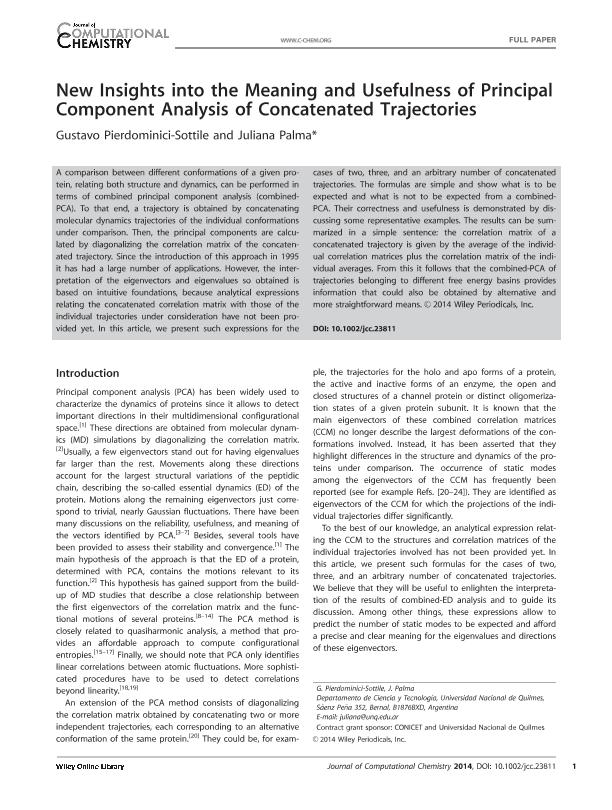Mostrar el registro sencillo del ítem
dc.contributor.author
Pierdominici Sottile, Gustavo

dc.contributor.author
Palma, Juliana Isabel

dc.date.available
2018-03-08T21:59:18Z
dc.date.issued
2015-03
dc.identifier.citation
Pierdominici Sottile, Gustavo; Palma, Juliana Isabel; New insights into the meaning and usefulness of principal component analysis of concatenated trajectories; John Wiley & Sons Inc; Journal Of Computational Chemistry; 36; 7; 3-2015; 424-432
dc.identifier.issn
0192-8651
dc.identifier.uri
http://hdl.handle.net/11336/38361
dc.description.abstract
A comparison between different conformations of a given protein, relating both structure and dynamics, can be performed in terms of combined principal component analysis (combined-PCA). To that end, a trajectory is obtained by concatenating molecular dynamics trajectories of the individual conformations under comparison. Then, the principal components are calculated by diagonalizing the correlation matrix of the concatenated trajectory. Since the introduction of this approach in 1995 it has had a large number of applications. However, the interpretation of the eigenvectors and eigenvalues so obtained is based on intuitive foundations, because analytical expressions relating the concatenated correlation matrix with those of the individual trajectories under consideration have not been provided yet. In this article, we present such expressions for the cases of two, three, and an arbitrary number of concatenated trajectories. The formulas are simple and show what is to be expected and what is not to be expected from a combined-PCA. Their correctness and usefulness is demonstrated by discussing some representative examples. The results can be summarized in a simple sentence: the correlation matrix of a concatenated trajectory is given by the average of the individual correlation matrices plus the correlation matrix of the individual averages. From this it follows that the combined-PCA of trajectories belonging to different free energy basins provides information that could also be obtained by alternative and more straightforward means.
dc.format
application/pdf
dc.language.iso
eng
dc.publisher
John Wiley & Sons Inc

dc.rights
info:eu-repo/semantics/openAccess
dc.rights.uri
https://creativecommons.org/licenses/by-nc-sa/2.5/ar/
dc.subject
Concatenated Trajectories
dc.subject
Conformational Changes
dc.subject
Essential Dynamics
dc.subject
Principal Component Analysis
dc.subject
Protein Dynamics
dc.subject.classification
Otras Ciencias Químicas

dc.subject.classification
Ciencias Químicas

dc.subject.classification
CIENCIAS NATURALES Y EXACTAS

dc.title
New insights into the meaning and usefulness of principal component analysis of concatenated trajectories
dc.type
info:eu-repo/semantics/article
dc.type
info:ar-repo/semantics/artículo
dc.type
info:eu-repo/semantics/publishedVersion
dc.date.updated
2018-03-08T19:03:30Z
dc.journal.volume
36
dc.journal.number
7
dc.journal.pagination
424-432
dc.journal.pais
Estados Unidos

dc.journal.ciudad
Nueva York
dc.description.fil
Fil: Pierdominici Sottile, Gustavo. Universidad Nacional de Quilmes. Departamento de Ciencia y Tecnología; Argentina. Consejo Nacional de Investigaciones Científicas y Técnicas; Argentina
dc.description.fil
Fil: Palma, Juliana Isabel. Consejo Nacional de Investigaciones Científicas y Técnicas; Argentina. Universidad Nacional de Quilmes. Departamento de Ciencia y Tecnología; Argentina
dc.journal.title
Journal Of Computational Chemistry

dc.relation.alternativeid
info:eu-repo/semantics/altIdentifier/url/http://onlinelibrary.wiley.com/doi/10.1002/jcc.23811/abstract
dc.relation.alternativeid
info:eu-repo/semantics/altIdentifier/doi/http://dx.doi.org/10.1002/jcc.23811
Archivos asociados
